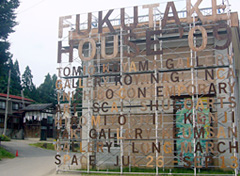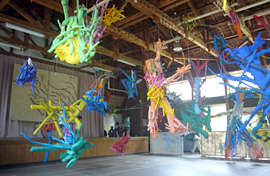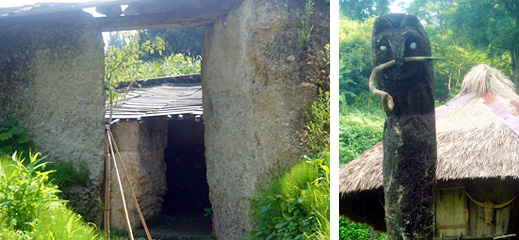 |
|
Here and There introduces art, artists, galleries and museums around Japan that non-Japanese readers and first-time visitors may find of particular interest. The writer claims no art expertise, just a subjective viewpoint acquired over many years' residence in Japan.
|
|
 |
|
|
 |
 |
Art in the Land of Rice and Snow: The Echigo-Tsumari Triennial
Alan Gleason |
 |
 |
|
 |
| The facade of Fukutake House, the former Myokayama Elementary School. |
|
Seizo Tashima's whimsical creatures fill the auditorium of the former Sanada Elementary School in Hachi. |
Home to Japan's deepest snows and most delicious rice (the prized Koshihikari), the Echigo-Tsumari region sprawls across 760 square kilometers of lush green hills and dales in southern Niigata prefecture, some two hours by train or three hours by car northwest of Tokyo.
Echigo-Tsumari is drop-dead gorgeous, but lately it has suffered hard times and more than its rightful share of natural catastrophes. One of Japan's deadliest earthquakes in recent years struck the region in 2004, and parts of it were isolated for days by record snowfalls in 2006. Still, these acts of god pale before the economic woes and relentless depopulation of the area, which show no sign of letup. Young people are moving away in droves, leaving only the elderly to tend to the farms. Among other consequences, local schools have been closing left and right.
Fortunately the region is also home to intrepid artist-activists like Fram Kitagawa, who launched a local arts festival in 2000 that has grown into what is rightly billed the world's largest such event. This year the Echigo-Tsumari Art Triennial boasts a mind-boggling 370 installations by artists from 38 countries -- spread over the entire region, occupying mountain tops, rice paddies, old farmhouses, and most heartening of all, a dozen of those closed and otherwise unused school buildings.
It is literally too much to behold: even with a couple of days to spare, your own car, and the excellent Triennial map (which assigns numbers to every exhibit and provides a list with Romanized artist names) you will barely be able to scratch the surface. Nor is it the sort of experience to rush through. The simple pleasure of roaming the twisty mountain roads from village to village, through endless vistas of field and forest, rivals the happy shock of seeing yet another quirky art object burst incongruously into view around the next bend.
As far as the harmony of art and environment is concerned, it's a mixed bag. Two refurbished schools in adjacent valleys provide a study in contrasts. One, renamed Fukutake House, has enjoyed inordinate hype thanks to the participation of several of Tokyo's trendiest contemporary art galleries. Though some of the artists have contributed work that alludes, often poignantly, to the abandonment of the school, many of the classrooms merely serve as transplanted urban venues for works that sit there smugly oblivious to their surroundings.
Drive over a mountain to the hamlet of Hachi, however, and you find an entire school converted into a kids' paradise by the picture-book author Seizo Tashima. Tashima has filled the classrooms with wild, colorful effigies of birds, beasts and monsters (all made of twigs picked up in the surrounding woods) that bring life and laughter back to a school that had only three pupils when it closed three years ago. One room is festooned with finger paintings produced on-site by young visitors; another artfully displays objects -- globes, clocks, lab equipment, rock collections -- left behind with the school.
Right next to the Sanada School, Takahide Mizuuchi has installed a hose and sprinkler system that arches over the valley. When the sun is shining at the right angle, on go the sprinklers, and a rainbow magically appears -- to the visible delight of elderly villagers and young urbanites alike.
High in a hollow above the town of Gejo, a thatched farmhouse that was built in 1924 -- but seems much older -- has been transformed into Ubusuna House, a gallery devoted to ceramic works by artists from all over Japan. Even the kitchen fixtures have gotten the potter's treatment, with the old kamado oven and chimney glazed with a playful design by Goro Suzuki. To top it off, local housewives serve a lunch of locally grown vegetables around the ceramicized irori hearth. It's a perfect example of how contemporary art can blend with and even enhance a traditional, rural setting, if some thought is put into it.
From Ubusuna House, walk five minutes further up the road to explore Hiroshi Furugori's womblike earthen labyrinth, which he calls Mishaguchi (Afterbirth). On your way downhill, stop by the Filipino farmhouse transplanted to a Niigata rice field by artist/filmmaker Kidlat Tahimik and a dozen young artisans from Ifugao, famed for its terraced paddies. The hut, which looks perfectly at home in Gejo, is an apt reminder of the common ground shared by rice-growing cultures around the world, and of their ongoing attrition. One can only hope that events like the Triennial provide a new lease on life for impoverished regions like the Echigo-Tsumari, and do not simply wind up exploiting their beauty as so much bucolic eye candy.
 |
| The 85-year-old Ubusuna House, identified by one of the Triennial's ubiquitous yellow banners. |
|
The oven and chimney in the Ubusuna kitchen, decorated by ceramic artist Goro Suzuki. |
|
 |
The Mishaguchi labyrinth, built of earth and stone by Hiroshi Furugori.
|
|
Ifugao house and statuary erected in a Gejo rice paddy, described by project leader Kidlat Tahimik as a "love letter to Japan."
All photos by Alan Gleason |
|
|
|
|
|
 |
|
 |
|
 |
Echigo-Tsumari Art Triennial 2009 |
|
26 July - 13 September 2009 |
 |
|
|
Echigo-Tsumari region, Tokamachi city and Tsunan town, Niigata prefecture
Phone inquiries: 025-595-6688
Transportation: Take the Joetsu Shinkansen train to Echigo-Yuzawa (80 minutes from Tokyo), then take the Hokuhoku line to Tokamachi or Matsudai station (25-35 minutes). Shuttle buses and bus tours to selected sites are available from Tokamachi and Matsudai. However, travel by car is recommended for access to the hundreds of exhibits scattered across this vast region. Tokamachi is a 30-minute drive west from the Muikamachi exit on the Kan'etsu Expressway, 200 kilometers northwest of Tokyo. |
 |
|
|
 |
 |
Alan Gleason
Alan Gleason is a translator, editor and writer based in Tokyo, where he has lived for 25 years. In addition to writing about the Japanese art scene he has edited and translated works on Japanese theater (from kabuki to the avant-garde) and music (both traditional and contemporary). |
|
|
|
 |
 |
|